Introduction
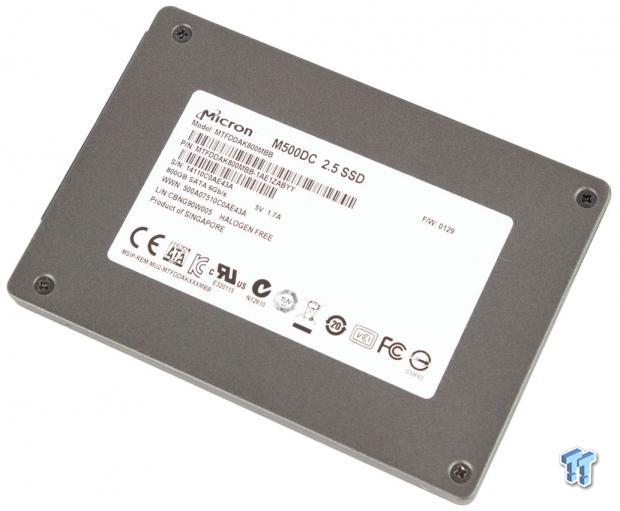
One size doesn't always fit all, and the continuing evolution of MLC SSDs has led to product segmentation from the large SSD manufacturers. There are now three distinct categories to address varying workloads: read-intensive, mixed-use, and write-intensive. These different categories allow administrators to select SSDs that precisely target their workload to provide the most economical means of addressing performance challenges. These different categories of SSDs are defined primarily by their write speed and endurance specifications.
Micron features one of the most diverse flash product stacks of the enterprise companies. Micron has entry-level SSDs for personal and business use, mission-critical SSDs, and PCIe SSDs in both MLC and SLC flavors. The M500 is the current value choice for light enterprise workloads. Its economical price point provides spacious capacity for those who prioritize price over all other factors. The M500 delivers solid performance and much lower latency than any HDD, but for those in the hunt for an SSD between Micron's flagship P400m and the M500, there hasn't been a choice…until now.
The M500DC rounds out the Micron product stack by providing a SATA 6Gb/s SSD tailored for mixed-use environments. By leveraging many of the same design aspects of the M500, such as L85A 20nm MLC NAND, Micron has also kept the price of the M500DC squarely in the value arena. Micron only charges a slight premium over the M500, but infuses a big boost in performance.
The 2.5-inch M550DC flaunts an astonishing 4k random write speed of 35,000 IOPS for the 480GB capacity we are testing today. This is within the realm of leading flagship 6Gb/s SSDs. Write speed scales with capacity, and the bookend 120 and 800GB capacities provide 23,000 and 24,000 4k random writes, respectively. The remaining capacity point, 240 GB, provides 33,000 IOPS. The random read speed is 63,000 IOPS for the three smaller capacities, and the 800GB model provides a slight boost to 65,000 IOPS.
The random performance of the M500DC is impressive, and there isn't currently an economical enterprise SSD with this performance level. Sequential speed isn't as impressive, with an average write speed ranging from 200 to 375 MB/s and a sequential read speed of 425 MB/s for all capacity points. It does bear mentioning that the percentage of users that purchase SSDs for their sequential performance is small; HDD's offer plenty of performance in that respect. In addition, generic measurements of sequential performance can be misleading. A spoiler: the M500DC provides surprisingly good performance in multi-threaded mixed sequential workloads.

The M500DC offers full-data path protection and die-level data redundancy as part of its comprehensive XPERT feature set, detailed on the following page, and an UBER rating of 1 per 10^15. Power loss protection is handled by tantalum capacitors, and the M500DC features a 2-million-hour MTTF.
With all of the bases covered for performance, and peripheral advantages normally incorporated into flagship-class SSDs, many will wonder what leads Micron to price the M500DC in such economical territory. The difference lies with the endurance; the M500DC only offers two Drive Writes Per Day (DWPD). This is a significantly lower threshold than SSDs destined for the most write-intensive workloads. The standard M500DC lacks encryption features. In many cases, encryption can be problematic for export sales for OEMs and ODMs, so the inclusion of standardized encryption isn't always the best solution for this class of drive. Micron also offers a TCG OPAL 2.0 option for those with encryption requirements.
Micron provides impressive performance at an unbelievably good price point. Let's take a quick look inside.
Micron M500DC Internals and Specifications
Micron M500DC Internals


The M500DC comes in a 2.5-inch form factor with a 7mm z-height and is available in the microserver friendly 1.8-inch form factor.


The large thermal pad sheds heat from the controller into the case, and two Micron DRAM chips total 1GB of capacity. The PCB appears barren with only eight 20nm MLC NAND packages in total. The 480GB model has 768GB of RAW capacity, giving it a 60 percent spare area. The only deviation in spare area comes with the 800GB model at 28 percent. This leads to lower random write specifications for the 800 GB capacity point and the same endurance as the 480GB model. Micron uses a 1:11 parity scheme that consumes part of the spare area, and the remainder is dedicated to overprovisioning.


Power capacitors line the bottom of the PCB, and the Marvell 9187 controller manages the drive. Micron has extensive experience with Marvel controllers and utilizes their own firmware with XPERT functionality.
eXtended Performance and Enhanced Reliability Technology (XPERT)
XPERT (eXtended Performance and Enhanced Reliability Technology) provides enhanced defect and error management technology through four integral components.
RAIN (Redundant Array of Independent NAND) calculates and stores parity. This RAID 5-like implementation operates at the device level, storing a 1:11 parity ratio for the 120, 240, and 480GB capacities, and 1:15 ratio for the 800GB drive. This facilitates data recovery in the event of an error or failure. RAIN provides extra data security in addition to the standard ECC approach, and it recovers lost data beyond page, block, and die-level failures. This transparent process takes place without any performance degradation, but it comes at the expense of capacity. RAIN relies upon extra NAND to store the data, but Micron compensates with extra spare area.
DataSAFE ensures data integrity during transfer through the drive interface, DRAM, error checkers, data concatenations, and the retirement of NAND. This is accomplished through CRC and ECC algorithms before and after each element in the data path.
ARM/OR (Adaptive Read Management/Optimized Read) dynamically tunes the NAND with DSP algorithms over the life of the device.
ReCal (Reduced Command Access Latency) utilizes a combination of latency reduction and wear leveling efficiency techniques to deliver consistent performance.
Micron M500DC Specifications
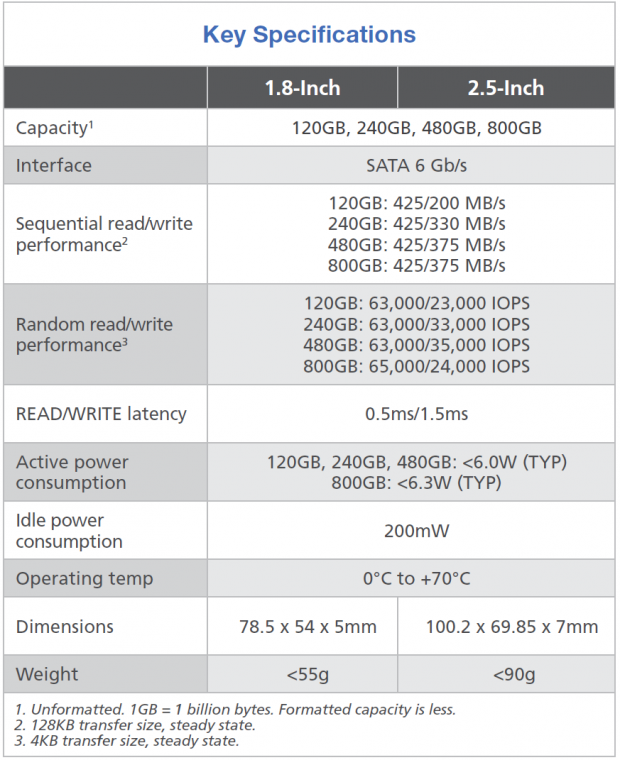
Endurance is rated at 0.5PB for the 120GB drive, 1.0PB for the 240GB drive, and 1.9PB for the 480GB and 800GB models.
Test System and Methodology


Our approach to storage testing targets long-term performance with a high level of granularity. Many testing methods record peak and average measurements during the test period. These average values give a basic understanding of performance, but they fall short in providing the clearest view possible of I/O Quality of Service (QoS).
'Average' results do little to indicate performance variability experienced during actual deployment. The degree of variability is especially pertinent as many applications can hang or lag as they wait for I/O requests to complete. This testing methodology illustrates performance variability, and includes average measurements, during the measurement window.
While under load, all storage solutions deliver variable levels of performance. While this fluctuation is normal, the degree of variability is what separates enterprise storage solutions from typical client-side hardware. Providing ongoing measurements from our workloads with one-second reporting intervals illustrates product differentiation in relation to I/O QoS. Scatter charts give readers a basic understanding of I/O latency distribution without directly observing numerous graphs.
Consistent latency is the goal of every storage solution, and measurements such as Maximum Latency only illuminate the single longest I/O received during testing. This can be misleading as a single 'outlying I/O' can skew the view of an otherwise superb solution. Standard Deviation measurements consider latency distribution, but do not always effectively illustrate I/O distribution with enough granularity to provide a clear picture of system performance. We utilize high-granularity I/O latency charts to illuminate performance during our test runs.
Our testing regimen follows SNIA principles to ensure consistent, repeatable testing. We measure power consumption during precondition runs. This provides measurements in time-based fashion, with results every second, to illuminate the behavior of power consumption in steady state conditions. We also present IOPS-to-Watts measurements to highlight efficiency.
We utilize SSDs with different capacity points for this evaluation. The 480GB Micron M500DC, the 240GB Samsung SM843, and the 480GB Intel DC S3500 are tested over their full LBA range to highlight performance at maximum utilization. The first page of results will provide the 'key' to understanding and interpreting our test methodology.
Benchmarks - 4k Random Read/Write
4k Random Read/Write

We precondition the 480GB Micron M500DC for 9,000 seconds, or two and a half hours, receiving performance reports every second. We plot this data to illustrate the drive's descent into steady state.
This dual-axis chart consists of 18,000 data points, with the IOPS on the left and the latency on the right. The red dots signify IOPS, and the grey dots are latency measurements during the test. We place latency data in a logarithmic scale to bring it into comparison range. The lines through the data scatter are the average during the test. This type of testing presents standard deviation and maximum/minimum I/O in a visual manner.
Note that the IOPS and latency figures are nearly mirror images of each other. This illustrates that high-granularity testing can give our readers a good feel for latency distribution by viewing IOPS at one-second intervals. This should be in mind when viewing our test results below. This downward slope of performance only occurs during the first few hours of use, and we present precondition results only to confirm steady state convergence.
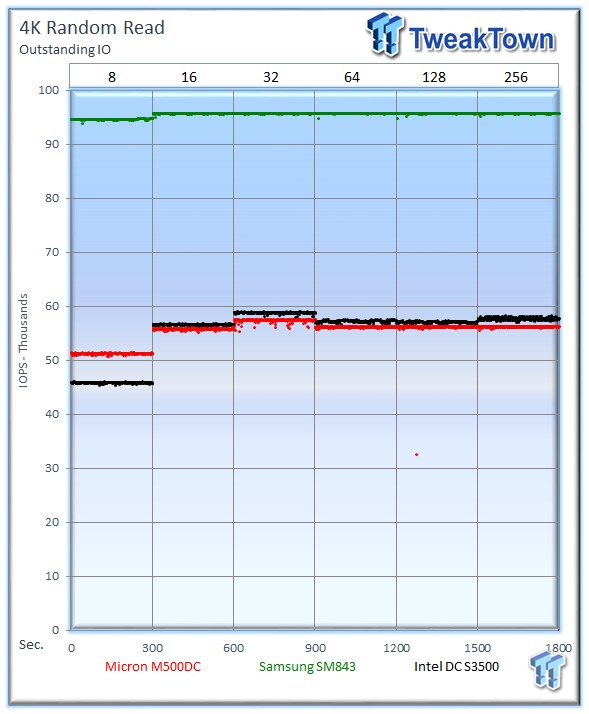
Each level tested includes 300 data points (five minutes of one second reports) to illustrate performance variability. The line for each OIO depth represents the average speed reported during the five-minute interval. 4k random speed measurements are an important metric when comparing drive performance as the hardest type of file access for any storage solution to master is small-file random. One of the most sought-after performance specifications, 4k random performance is a heavily marketed figure.
The Micron M500DC averages 56,259 IOPS with a 4k random read workload at 256 OIO (Outstanding I/O). The Intel DC S3500 averages 57,769 IOPS, and the Samsung SM843 takes the lead with 95,815 IOPS. The Micron and Intel SSDs are closely matched, but the Samsung SSD continues to lead the pure read testing for our value-SSD test pool.

The SM843 leads convincingly with the lowest latency during 4k random read activity.

Garbage collection routines are more pronounced in heavy write workloads, leading to performance variability.
The Micron M500DC distances itself from the pack with an outstanding average of 39,089 IOPS; the Intel averages 13,841 IOPS, and the Samsung provides 12,432 IOPS at 256 OIO. The M500DC's impressive write speed raises the performance bar far above any other value-oriented SATA SSDs. This level of performance is common with flagship 6Gb/s SSD products and is certainly unexpected from the M500DC with its much lower price point.

The M500DC exhibits a well-defined and consistent latency distribution during the test. This is a big differentiator from the other value SSDs, which experience some turbulence at heavier OIO.

Our write percentage testing illustrates the varying performance of each solution with mixed workloads. The 100% column to the right is a pure write workload of the 4k file size, and 0% represents a pure 4k read workload. Mixed workload testing reveals strengths, and weaknesses, that remain hidden during typical tests. In reality, much of the real-world data is going to feature mixed data.
Here we observe the Samsung SM843 leading by a wide margin with the pure random read workload on the left, but with the slightest of writes interspersed (10%), it falls to the lowest performance of the test field. Remarkably, the conservative read speed of the M500DC actually rises when we mix in a slight write workload, and then it begins the expected descent as more we add more write activity. The performance of both competing SSDs continues to fall as we move across the chart, but the M500DC comfortably leads the majority of this test. This superior handling of mixed read/write workloads is very important for application performance.

We record the power consumption measurements during our precondition run. We calculate the stated average results during the last five minutes of the test, after the device has settled into steady state.
The M500DC averages 4.09 watts, the DC S3500 averages 3.8 watts, and the SM843 averages 2.66 watts during the measurement window. We measure during write activity, and this higher power consumption equates directly to the superior performance of the M500DC during the workload, as evidenced in IOPS-to-Watts measurements below.

IOPS-to-Watts measurements are generated from data recorded during our precondition run, and the stated average is from the last five minutes of the test.
The M500DC jumps to a big lead, averaging 9,545 IOPS-per-Watt. The DC S3500 averages 3,125, and the SM843 averages 4,621.
Benchmarks - 8k Random Read/Write
8k Random Read/Write


Server workloads rely heavily upon 8k performance, and we include this as a standard with each evaluation. Many of our server emulations also test 8k performance with various mixed read/write workloads.
The average 8k random read speed of the Micron M500DC is 48,034 IOPS at 256 OIO; the Intel DC S3500 measures 44,444 IOPS, and the Samsung SM843 ekes out the win with 48,277 IOPS. The SM843 again provides impressive read speed, but it does not outpace the M500DC by nearly as large of a margin as observed with 4k random read activity.

All three SSDs exhibit a tight latency range during the 8k random read test.
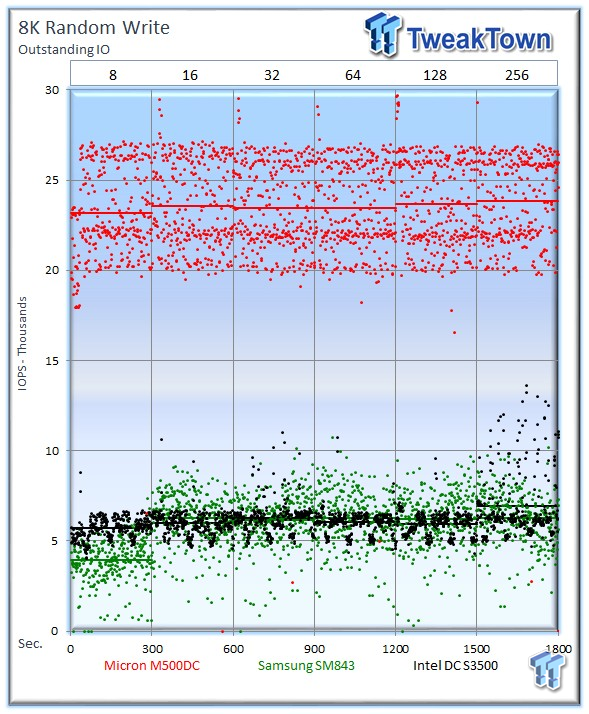
The M500DC easily leads with an average of 23,852 IOPS. The DC S3500 averages 6,937 IOPS, and the SM843 averages 6,254 IOPS at 256 OIO.

The M500DC delivers tight, consistent performance during the test period. The DC S3500 also has a tightly defined latency envelope, but it is much higher than the M500DC.

The M500DC owns the 8k mixed workload testing with a large lead during the majority of the test. While the DC S3500 has a tighter performance profile, it is well below the M500DC.

Power consumption for the M500DC averages 4.77 watts. The DC S3500 averages 3.75 watts during the measurement window, and the SM843 requires 2.71 watts.

The M500DC leads the efficiency test convincingly with 4,877 IOPS-per-Watt. The DC S3500 averages 1,584 IOPS-per-Watt, and the SM843 measures 2,234 IOPS-per-Watt.
Benchmarks - 128k Sequential Read/Write
128k Sequential Read/Write


128k sequential speed reflects the maximum sequential throughput of the SSD. The Micron M500DC features the lowest sequential performance specifications of the value-SSD lineup. The M500DC weighs in with a sequential read speed of 417 MB/s. The Intel DC S3500 delivers an average of 441 MB/s, and the Samsung SM843 averages a commanding 528 MB/s.

The SM843 provides the lowest overall latency.

The M500DC averages 388 MB/s. The DC S3500 averages 424 MB/s, and the SM843 delivers another win with 501 MB/s.


On the surface, the SM843 would appear to be the best SSD with sequential read and write activity. Our mixed workload testing reveals otherwise. The SM843 and DC S3500 both exhibit a 'bathtub' performance profile with sequential workloads. This is identified by the high marks in pure read/write environments, but sagging performance in the middle. The slightest of mixed workloads sends their performance much lower, while the M500DC delivers steadier performance throughout the test. The SM843 and DC S3500 actually only lead in two of the 11 tests, and the M500DC provides superior mixed sequential workload performance.
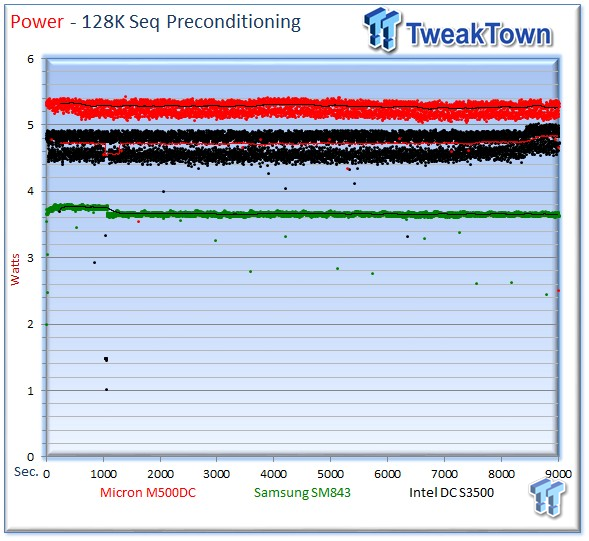
The M500DC averages 5.24 watts. The DC S3500 averages 4.83 watts, and the SM843 requires 3.65W for the sequential write workload.

The M500DC averages 73 MB/s-per-Watt; the DC S3500 averages 87 MB/s-per-Watt, and the SM843 leads with a convincing 136 MB/s-per-Watt.
Benchmarks - Database/OLTP and Web Server
Database/OLTP


This test emulates Database and On-Line Transaction Processing (OLTP) workloads. OLTP is the processing of transactions such as credit cards and high frequency trading in the financial sector. Databases are the bread and butter of many enterprise deployments. These demanding 8k random workloads with a 66 percent read and 33 percent write distribution bring even the best solutions down to earth.
The Micron M500DC tops the chart with an average of 21,133 IOPS; the Intel DC S3500 averages 19,400 IOPS at 256 OIO, and the Samsung SM843 averages 13,653 IOPS. The M500DC experiences significant variability, but even the low range of performance is higher than the nearest competitor for five of the six loads. This high performance is a direct result of the enhanced random write performance.


The M500DC averages 2.76 watts; the DC S3500 averages 3.76 watts, and the SM843 requires 2.43 watts.

The M500DC averages 7,676 IOPS-per-Watt; the DC S3500 averages 4,040 IOPS-per-Watt, and the SM843 averages 5,969 IOPS-per-Watt.
Web Server


The Web Server profile is a read-only test with a wide range of file sizes. Web servers are responsible for generating content users view over the Internet, much like the very page you are reading. The speed of the underlying storage system has a massive impact on the speed and responsiveness of the server hosting the website.
The M500DC doesn't fare nearly as well in this read-centric workload as the other two contenders. The M500DC averages 18,650 IOPS, falling to the DC S3500 average of 23,664 IOPS and the SM843 average of 28,800 at 256 OIO.


The M500DC averages 3.21 watts; the DC S3500 requires 3.8 watts during the fileserver workload, and the SM843 pulls 2.7 watts.

The M500DC scores 1,965 IOPS-per-Watt, compared to 749 IOPS-per-Watt for the DC S3500 and 1,094 for the SM843.
Benchmarks - Email Server
Email Server


The email server profile is a demanding 8k test with a 50% read and 50% write distribution. This application is indicative of the performance in heavy write workloads.
The Micron M500DC averages 15,403 IOPS; the Intel DC S3500 averages 13,121 IOPS at 256 OIO, and the Samsung SM843 lags behind at 11,839 IOPS. The M500DC does very well in write-centric workloads, and it delivers a commanding lead in this test.


The M500DC averages 2.66 watts; the DC S3500 averages 1.75 watts, and the SM843 averages 2.68 watts.

The M500DC averages 5,806 IOPS-per-Watt; the DC S3500 scores 6,705 IOPS-per-Watt, and the SM843 delivers 4,491 IOPS-per-Watt.
Final Thoughts

The key to any deployment is to maximize application performance in the smallest footprint possible. In the past, this usually consisted of SSDs tailored for the most intense workloads. This doesn't mesh well with administrators when the workload doesn't require bleeding-edge performance or bulletproof endurance. Underutilizing an expensive resource is never the optimal solution, leading many to turn to light-workload SSDs, such as the M500. In Micron's case, there wasn't a clear middle of the road solution between the M500 and the P400m. The M500DC comes in and compliments their product stack with a mixed-use SSD with superior performance to the M500, but a similar price point.
The ubiquitous SATA connection is ever-present in the datacenter, making SSDs an easy drop-in solution to address performance challenges. While SAS and PCIe are expected to grow, the pervasive SATA connection isn't going to die anytime soon. The Micron M500DC is destined for a variety of demanding workloads, from logging applications, financial databases, and virtualized appliances to Video-On-Demand services. This fills the gap between mission-critical class SSDs and read-centric drives.
In our testing, the M500DC delivered surprising resilience in random write workloads. In a pure-random write environment, the M500DC dominates, delivering robust performance above flagship-class 6Gb/s products. Generic read/write performance specifications ignore real-world use-cases, where very few workloads fit into the perfect 'all-read' or 'all-write' pattern. The M500DC also delivered commanding performance in mixed workloads, easily outstripping the two comparison SSDs. This great performance carried over to our server workloads, with a strong showing in OLTP and Email workloads highlighting solid performance in mixed-random workloads.
Most users will not turn to SSDs to boost sequential performance in read or write-centric workloads; most HDDs provide decent performance in this aspect. On the surface, sequential performance of the M500DC is well below the competition. Our mixed workload testing revealed a pleasant surprise, and the M500DC dominated nine of the 11 mixed sequential workloads. This bodes well for sequential performance in multi-threaded applications where most workloads reside.
The M500DC is obviously tuned for random write workloads; the only dark spot in performance appeared in the read-only web server workload. Power consumption and efficiency is impressive, topping our charts in most workloads with the notable exception of the sequential write workload.
The fabs are lining up with very competitive pricing in the value segment. Intel's DC S3500 is competitively priced and is one of the current go-to SSDs for light workloads. The M500DC outperforms the DC S3500 in most aspects, and though its performance isn't as consistent, its performance range is above that of the DC S3500, and at a price point that is within a few cents per GB.
Delivering outstanding performance that rivals even leading 6Gb/s mission-critical SATA SSDs in random write workloads at an outstanding price point is a stellar achievement. There is the notable sacrifice of endurance to meet the price constraints, but for those in the hunt for solid performance, the M500DC delivers leading performance in the value segment. Micron has lifted the bar in the mixed-use value class SSD arena, meriting the TweakTown Editor's Choice Award.


 United
States: Find other tech and computer products like this
over at
United
States: Find other tech and computer products like this
over at  United
Kingdom: Find other tech and computer products like this
over at
United
Kingdom: Find other tech and computer products like this
over at  Australia:
Find other tech and computer products like this over at
Australia:
Find other tech and computer products like this over at  Canada:
Find other tech and computer products like this over at
Canada:
Find other tech and computer products like this over at  Deutschland:
Finde andere Technik- und Computerprodukte wie dieses auf
Deutschland:
Finde andere Technik- und Computerprodukte wie dieses auf